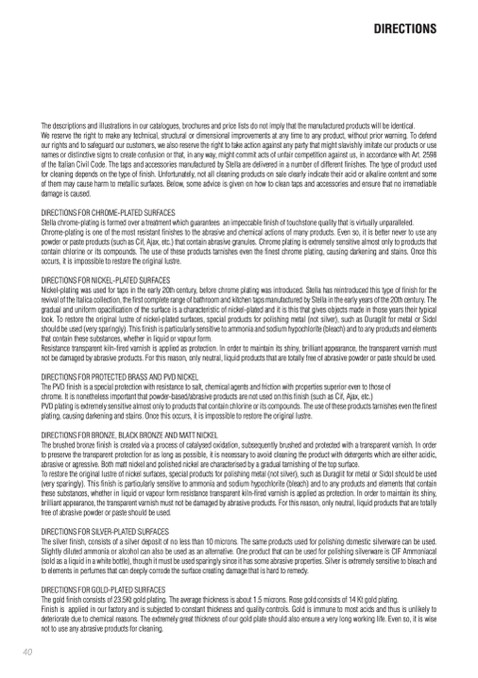
40
The descriptions and illustrations in our catalogues, brochures and price lists do not imply that the manufactured products will be identical.
We reserve the right to make any technical, structural or dimensional improvements at any time to any product, without prior warning. To defend
our rights and to safeguard our customers, we also reserve the right to take action against any party that might slavishly imitate our products or use
names or distinctive signs to create confusion or that, in any way, might commit acts of unfair competition against us, in accordance with Art. 2598
of the Italian Civil Code. The taps and accessories manufactured by Stella are delivered in a number of different finishes. The type of product used
for cleaning depends on the type of finish. Unfortunately, not all cleaning products on sale clearly indicate their acid or alkaline content and some
of them may cause harm to metallic surfaces. Below, some advice is given on how to clean taps and accessories and ensure that no irremediable
damage is caused.
DIRECTIONS FOR CHROME-PLATED SURFACES
Stella chrome-plating is formed over a treatment which guarantees an impeccable finish of touchstone quality that is virtually unparalleled.
Chrome-plating is one of the most resistant finishes to the abrasive and chemical actions of many products. Even so, it is better never to use any
powder or paste products (such as Cif, Ajax, etc.) that contain abrasive granules. Chrome plating is extremely sensitive almost only to products that
contain chlorine or its compounds. The use of these products tarnishes even the finest chrome plating, causing darkening and stains. Once this
occurs, it is impossible to restore the original lustre.
DIRECTIONS FOR NICKEL-PLATED SURFACES
Nickel-plating was used for taps in the early 20th century, before chrome plating was introduced. Stella has reintroduced this type of finish for the
revival of the Italica collection, the first complete range of bathroom and kitchen taps manufactured by Stella in the early years of the 20th century. The
gradual and uniform opacification of the surface is a characteristic of nickel-plated and it is this that gives objects made in those years their typical
look. To restore the original lustre of nickel-plated surfaces, special products for polishing metal (not silver), such as Duraglit for metal or Sidol
should be used (very sparingly). This finish is particularly sensitive to ammonia and sodium hypochlorite (bleach) and to any products and elements
that contain these substances, whether in liquid or vapour form.
Resistance transparent kiln-fired varnish is applied as protection. In order to maintain its shiny, brilliant appearance, the transparent varnish must
not be damaged by abrasive products. For this reason, only neutral, liquid products that are totally free of abrasive powder or paste should be used.
DIRECTIONS FOR PROTECTED BRASS AND PVD NICKEL
The PVD finish is a special protection with resistance to salt, chemical agents and friction with properties superior even to those of
chrome. It is nonetheless important that powder-based/abrasive products are not used on this finish (such as Cif, Ajax, etc.)
PVD plating is extremely sensitive almost only to products that contain chlorine or its compounds. The use of these products tarnishes even the finest
plating, causing darkening and stains. Once this occurs, it is impossible to restore the original lustre.
DIRECTIONS FOR BRONZE, BLACK BRONZE AND MATT NICKEL
The brushed bronze finish is created via a process of catalysed oxidation, subsequently brushed and protected with a transparent varnish. In order
to preserve the transparent protection for as long as possible, it is necessary to avoid cleaning the product with detergents which are either acidic,
abrasive or agressive. Both matt nickel and polished nickel are characterised by a gradual tarnishing of the top surface.
To restore the original lustre of nickel surfaces, special products for polishing metal (not silver), such as Duraglit for metal or Sidol should be used
(very sparingly). This finish is particularly sensitive to ammonia and sodium hypochlorite (bleach) and to any products and elements that contain
these substances, whether in liquid or vapour form resistance transparent kiln-fired varnish is applied as protection. In order to maintain its shiny,
brilliant appearance, the transparent varnish must not be damaged by abrasive products. For this reason, only neutral, liquid products that are totally
free of abrasive powder or paste should be used.
DIRECTIONS FOR SILVER-PLATED SURFACES
The silver finish, consists of a silver deposit of no less than 10 microns. The same products used for polishing domestic silverware can be used.
Slightly diluted ammonia or alcohol can also be used as an alternative. One product that can be used for polishing silverware is CIF Ammoniacal
(sold as a liquid in a white bottle), though it must be used sparingly since it has some abrasive properties. Silver is extremely sensitive to bleach and
to elements in perfumes that can deeply corrode the surface creating damage that is hard to remedy.
DIRECTIONS FOR GOLD-PLATED SURFACES
The gold finish consists of 23.5Kt gold plating. The average thickness is about 1.5 microns. Rose gold consists of 14 Kt gold plating.
Finish is applied in our factory and is subjected to constant thickness and quality controls. Gold is immune to most acids and thus is unlikely to
deteriorate due to chemical reasons. The extremely great thickness of our gold plate should also ensure a very long working life. Even so, it is wise
not to use any abrasive products for cleaning.
DIRECTIONS

